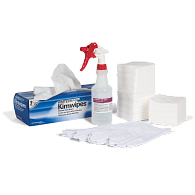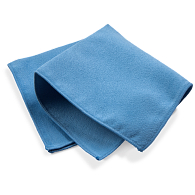Acrylic is a lightweight, clear plastic that can be used in a wide variety of applications. It can be cut, glued, heated, bent and shaped into items used to hold, display and cover artifacts in storage as well as on exhibit.
While acrylic is a versatile product with many uses, it also requires care and consideration to prevent damage. The possibility of damage is highest during cleaning, handling and storage. Glued edges can split, abrasions can mar the surface, and cracking or breakage are possible if items are not handled and stored properly.
Cleaning Acrylic
This applies to items made from acrylic, such as risers, mounts, stands and standard & UV-filtering acrylic vitrines. Specialty acrylics, such as Optium, require specialized cleaning not covered here.
- Cleaning should only happen when the vitrine is dirty
- When selecting a cleaner, stick with products made specifically for acrylic, such as NOVUS, Acrifix® or Brillianize®. They reduce static and keep the acrylic from attracting dust.
- Ammonia and alcohol-based cleaners can cause yellowing, hazing, microfractures, cracks and scratches.
- Use a nonabrasive, low-lint cleaning cloth when cleaning acrylic.
- Don’t use paper towels as they can cause scratches.
- Spray the cleaner onto the cloth, then apply to the acrylic. Use the dry side of the cloth to buff the area and remove any lingering liquid.
- For scratches, use NOVUS scratch removal products. The 3-step system can buff away fine and heavy scratches.
Handling Acrylic Vitrines
- Always make sure you have enough people to properly lift and support the vitrine.
- Before removing a vitrine, make sure there is a clear open space for it to be set down.
- Wearing gloves or using vacuum cups can help maintain grip
- Never carry or hold a vitrine by its sides because this will weaken the seams, causing the seams to fail.
- Always hold the vitrine upright and support the bottom edges.
- Four-sided vitrines on cases like Metro™ Gramercy Case require extra support when being removed because the vitrine can easily be shifted out of square, causing damage to the seams.
Storing & Transporting Acrylic Vitrines
- Wrap/cover each piece with a nonabrasive material such as tissue, polyethylene foam or polyethylene bags.
- Don’t place acrylic in direct contact with products like bubble wrap
- Like items of different sizes (such as risers) can be nested if they are not directly touching.
- Items can be stacked, once wrapped, if they are supported properly
- Do not place any weight on top of vitrines.
- Store items on a shelf on the edge with the most strength
- Do not lay vitrines on their sides as that will strain the glued edges.
- Stand vitrines on their bottom edges, as they would be when on a base or turn upside down and rest on the top side.


